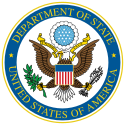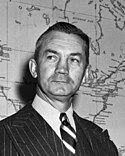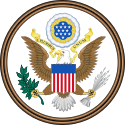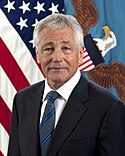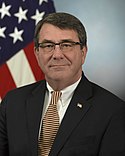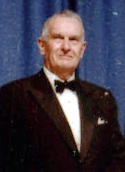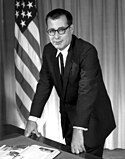Verteidigungsminister der Vereinigten Staaten
| Verteidigungsminister der Vereinigten Staaten | |
|---|---|
| United States Secretary of Defense | |
 | |
| Siegel des DoD | |
 | |
| Standarte des Verteidigungsministers | |
 | |
| Amtierend Pete Hegseth seit dem 24. Januar 2025 | |
| Office of the Secretary of Defense | |
| Anrede | Mr. Secretary (informell) The Honorable (formell) |
| Amtssitz | Pentagon, Arlington County, Virginia |
| Vorsitzender von | Verteidigungsministerium der Vereinigten Staaten |
| Mitglied von | Kabinett der Vereinigten Staaten National Security Council |
| Amtszeit | keine feste Amtszeit |
| Vorläufer | Secretary of War |
| Stellvertreter | United States Deputy Secretary of Defense |
| Ernennung durch | Präsident mit Beratung und Zustimmung des Senats |
| Schaffung des Amtes | 17. September 1947 |
| Erster Amtsinhaber | James V. Forrestal |
| Gehalt | Executive Schedule, Level I[1] |
| Website | [1] |
Als Secretary of Defense (SecDef, deutsch „Verteidigungsminister“) wird in den Vereinigten Staaten der Leiter des Verteidigungsministeriums der Vereinigten Staaten (United States Department of Defense) bezeichnet. Das Amt entspricht dem, was in den meisten Ländern als Verteidigungsminister bezeichnet wird. Als ein Vorläufer kann das Amt des Kriegsministers (Secretary of War) angesehen werden.
Liste der Verteidigungsminister
| Nr. | Bild | Name | Amtszeit | unter US-Präsident |
|---|---|---|---|---|
| 1 |  | James V. Forrestal | 17. September 1947– 28. März 1949 | Harry S. Truman |
| 2 |  | Louis A. Johnson | 28. März 1949– 19. September 1950 | |
| 3 |  | George C. Marshall | 21. September 1950– 12. September 1951 | |
| 4 |  | Robert A. Lovett | 17. September 1951– 20. Januar 1953 | |
| 5 |  | Charles E. Wilson | 28. Januar 1953– 8. Oktober 1957 | Dwight D. Eisenhower |
| 6 |  | Neil H. McElroy | 9. Oktober 1957– 1. Dezember 1959 | |
| 7 |  | Thomas S. Gates | 2. Dezember 1959– 20. Januar 1961 | |
| 8 |  | Robert McNamara | 21. Januar 1961– 29. Februar 1968 | John F. Kennedy, Lyndon B. Johnson |
| 9 |  | Clark M. Clifford | 1. März 1968– 20. Januar 1969 | Lyndon B. Johnson |
| 10 |  | Melvin R. Laird | 22. Januar 1969– 29. Januar 1973 | Richard Nixon |
| 11 |  | Elliot L. Richardson | 30. Januar 1973– 24. Mai 1973 | |
| interim |  | Bill Clements | 24. Mai 1973– 2. Juli 1973 | |
| 12 |  | James R. Schlesinger | 2. Juli 1973– 19. November 1975 | Richard Nixon, Gerald Ford |
| 13 |  | Donald Rumsfeld (1. Amtszeit) | 20. November 1975– 20. Januar 1977 | Gerald Ford |
| 14 |  | Harold Brown | 21. Januar 1977– 20. Januar 1981 | Jimmy Carter |
| 15 |  | Caspar Weinberger | 21. Januar 1981– 23. November 1987 | Ronald Reagan |
| 16 |  | Frank Carlucci | 23. November 1987– 20. Januar 1989 | |
| interim |  | William Howard Taft IV | 20. Januar 1989– 21. März 1989 | George H. W. Bush |
| 17 |  | Dick Cheney | 21. März 1989– 20. Januar 1993 | |
| 18 |  | Leslie Aspin | 21. Januar 1993– 3. Februar 1994 | Bill Clinton |
| 19 |  | William Perry | 3. Februar 1994– 23. Januar 1997 | |
| 20 |  | William Cohen | 23. Januar 1997– 20. Januar 2001 | |
| 21 |  | Donald Rumsfeld (2. Amtszeit) | 20. Januar 2001– 18. Dezember 2006 | George W. Bush |
| 22 |  | Robert Gates | 18. Dezember 2006– 1. Juli 2011 | George W. Bush, Barack Obama |
| 23 |  | Leon Panetta | 1. Juli 2011– 26. Februar 2013[2] | Barack Obama |
| 24 |  | Chuck Hagel | 27. Februar 2013– 12. Februar 2015[3][4] | |
| 25 |  | Ashton Carter | 12. Februar 2015– 20. Januar 2017 | |
| 26 | James N. Mattis | 20. Januar 2017– 31. Dezember 2018[5] | Donald Trump | |
| interim |  | Patrick M. Shanahan | 1. Januar 2019– 23. Juni 2019 | |
| interim |  | Mark Esper | 24. Juni 2019– 15. Juli 2019 | |
| interim |  | Richard V. Spencer | 15. Juli 2019– 23. Juli 2019 | |
| 27 |  | Mark Esper | 23. Juli 2019– 9. November 2020 | |
| interim |  | Christopher C. Miller | 9. November 2020– 20. Januar 2021 | |
| interim |  | David Norquist | 20. Januar 2021– 22. Januar 2021 | Joe Biden |
| 28 |  | Lloyd Austin | 22. Januar 2021– 20. Januar 2025 | |
| interim |  | Robert G. Salesses | 20. Januar 2025 – 24. Januar 2025 | Donald Trump |
| 29 |  | Pete Hegseth | Seit 24. Januar 2025 |
Einzelnachweise
- ↑ 5 U.S.C. § 5312
- ↑ Panetta Bids Farewell to Defense Department Team
- ↑ www.defense.gov Senate Confirms Hagel as Defense Secretary
- ↑ www.tagesschau.de US-Verteidigungsminister tritt zurück – Hagel geht, wer kommt? ( vom 25. November 2014 im Internet Archive)
- ↑ Erin Laviola: Patrick Shanahan: 5 Fast Facts You Need to Know. In: heavy.com. 23. Dezember 2018, abgerufen am 23. Dezember 2018 (englisch).
Auf dieser Seite verwendete Medien
Dr. Mark T. Esper, 23rd secretary of the U.S. Army
Seal of the United States Department of Homeland Security. A graphically styled American eagle appears in a circular blue field. The eagle's outstretched wings break through an inner red ring into an outer white ring that contains a circular placement of the words "U.S. DEPARTMENT OF" in the top half and "HOMELAND SECURITY" in the bottom half. The outer white ring has a silvery gray border. As in The Great Seal, the eagle’s left claw holds an olive branch with 13 leaves and 13 seeds while the right claw grasps 13 arrows. Centered on the eagle's breast is a shield divided into three sections containing elements that represent the homeland "from sea to shining sea." The top element, a dark blue sky, contains 22 stars representing the original 22 agencies and bureaus that have come together to form the department. The left shield element contains white mountains behind a green plain underneath a light blue sky. The right shield element contains four wave shapes representing the oceans, lakes and waterways alternating light and dark blue separated by white lines.
Seal of the United States Department of Housing and Urban Development.
The seal was originally unveiled on November 10, 1966, and later defined in law (Federal Register 32FR366-67 and 24 CFR subtitle A, §11.1, both since removed as part of a streamlining of the federal code). The seal was defined as:
On a white background within a circle composed of the words, "U.S. Department of Housing and Urban Development," is an eagle and two stars. The six upper bars depicting the upper portion of the eagle's wings, the torso of the eagle, the star at the right of the eagle, and the words, "U.S. Department of Housing and Urban Development," are colored blue. The eight lower bars depicting the lower portion of the eagle's wings and the star at the left of the eagle are colored green."
The seal is a representative of high rise buildings simulating an eagle and giving emphasis to the "urban" in HUD's name. The eagle (shown abstractly) is a symbol of Federal authority. The use of green symbolizes open space, land, growth and prosperity. The blue in the Seal alludes to the quality of life and environment in America's cities.
More information here.Secretary of Defense Leon E. Panetta.
The seal of the United States Department of the Treasury.
The original seal dates from the Board of Treasury during the Articles of Confederation, and so predates the department (and Federal Government) itself. The current design is a slight simplification of the original, introduced in 1968.
The seal's arms depicts balancing scales (to represent justice), a key (the emblem of official authority) and a chevron with thirteen stars (to represent the original states).
For more information, see here.Christopher Miller, Deputy Assistant Secretary of Defense Special Operations and Combating Terrorism, poses for his official portrait in the Army portrait studio at the Pentagon in Arlington, Va., Jan. 23, 2020. (U.S. Army photo by Spc. Zachery Perkins)
Seal of the United States Department of Justice.
The origins of the seal are unknown; it was first used in the 19th century as the seal for the Office of the Attorney General (prior to the formation of the Department of Justice) but the exact date is unknown. Even the translation of the Latin motto is murky, a matter of debate between Latin scholars. The Department's currently accepted translation is who prosecutes on behalf of Lady Justice, referring to the Attorney General. The motto is an allusion to the wording of the writ in a qui tam action: qui tam pro domino rege quam pro se ipso sequitur ("he who sues on behalf of our lord the King as well as for himself." The current-day seal dates from 1934, when some (though not all) of the heraldic mistakes on the original were corrected. More information here.The seal of the United States Department of Health and Human Services. The symbol represents the American People sheltered in the wing of the American Eagle, suggesting the Department’s concern and responsibility for the welfare of the people. The colors are reflex blue and gold.
This seal is now just used for mainly legal purposes; the department has a separate logo which is used for its visual identity.
More information here and here.The personal flag of the United States Secretary of Defense.
Seal of the United States Department of Education.
The seal was introduced on May 7, 1980, and is described in law as:More information here and 34 CFR Part 3.Standing upon a mound, an oak tree with black trunk and limbs and green foliage in front of a gold rising sun, issuing gold rays on a light blue disc, enclosed by a dark blue border with gold edges bearing the inscription "DEPARTMENT OF EDUCATION" above a star at either side of the words "UNITED STATES OF AMERICA" in smaller letters in the base; letters and stars in white.
Seal of the US Environmental Protection Agency (EPA).
Robert G.Salesses, U.S. Deputy Assistant Secretary of Defense for Defense Continuity and Mission Assurance
Frank Carlucci
29th Secretary of Defense Pete Hegseth Official Portrait (DoD photo by Chad J. McNeeley)
Seal of the United States Department of Transportation, introduced on 17 November 1980. The seal is described in 49 CFR 3.1 as 'A white abstract triskelion figure signifying motion appears within a circular blue field. The figure is symmetrical. The three branches of the figure curve outward in a counter-clockwise direction, each tapering almost to a point at the edge of the field. Surrounding the blue circle is a circular ring of letters. The upper half of the ring shows the words “Department of Transportation”. The lower half of the ring shows the words “United States of America”. The letters may be shown in either black or medium gray. The official seal of the Department is modified when embossed. It appears below in black and white.'
Mr. Richard V. Spencer, Acting Secretary of Defense , poses for his official portrait in the Army portrait studio at the Pentagon in Arlington, Va, June. 25, 2019. (U.S. Army photo by William Pratt)
Official portrait of Secretary of Defense Richard B. Cheney, who would later become vice president.
United States Secretary of Defense Chuck Hagel's official portrait.
Seal of the United States Department of the Interior.
The seal consists of a male bison with the head and body in a left position, standing on a prairie, with mountains and a rising sun in the background, enclosed within two concentric circles, having the words "U.S. Department of the Interior" and the date "March 3, 1849" (when Congress created the department) inscribed in the top and bottom arcs within these circles. See here for more information.
The bison seal dates from 1917, when it was used as the emblem on the initial department flag and thereafter replaced the old version of the seal, which used a federal eagle. The eagle was reinstated for a few years in the 1920s, and a different seal was used from 1968-69, but on both occasions the bison seal was reinstated. For more information see this chapter in The Department of Everything Else: Highlights of Interior History.The creation of the new Department of Veterans Affairs in 1989 required a new official seal to represent VA. In November 1988, after the law establishing VA as a cabinet department was signed, VA initiated a competition among employees for a seal design that would give the new department a "new look." The winner of that competition, and creator of today's VA seal was David E. Gregory, a medical media production specialist at the Indianapolis VA Medical Center. These are the key elements of the seal, as he described them:
- The eagle represents the United States.
- The circle of five stars above the eagle represents the Army, Navy, Air Force, Marines and Coast Guard.
- The two flags in the eagle's talons represent the span of America's history from 13 colonies to the present 50 states.
- The flags are bound by a golden cord symbolic of those Americans who have fallen in service to their country.
- The eagle holds the cord to perpetuate the memory of those veterans who have fallen and sacrificed for the nation.
US Department of Defense portrait of Ashton B. Carter, Deputy Secretary of Defense.
Secretary of Defense Donald H. Rumsfeld. DoD photo by Scott Davis, U.S. Army. (Released).
Patrick M. Shanahan, Deputy Secretary of Defense, poses for his official portrait in the Army portrait studio at the Pentagon in Arlington, Virginia, July 19, 2017.
Seal of the Vice President of the United States. The blazon is defined in Executive Order 11884 as:
The design is the same as the Seal of the President of the United States, except that there is no ring of stars, the clouds are gray (instead of proper), the stars are gray (instead of argent), the scroll is gray (instead of white), the arrows are gray (instead of proper), and the background colors and inscription (obviously) differ.The Coat of Arms of the Vice President of the United States shall be of the following design:
SHIELD: Paleways of thirteen pieces argent and gules, a chief azure; upon the breast of an American eagle displayed holding in his dexter talon an olive branch proper and in his sinister a bundle of thirteen arrows gray, and in his beak a gray scroll inscribed "E PLURIBUS UNUM" sable.
CREST: Behind and above the eagle a radiating glory or, on which appears an arc of thirteen cloud puffs gray, and a constellation of thirteen mullets gray.
The Seal of the Vice President of the United States shall consist of the Coat of Arms encircled by the words "Vice President of the United States."
Texas governor Bill Clements
Close-up of Donald Rumsfeld
Seal of the United States Department of Commerce.
The seal was approved on April 4, 1913 and is derived from the seal of the defunct United States Department of Commerce and Labor. It is composed of the arms (Per fesse azure and or, a ship in full sail on waves of the sea, in chief proper; and in base a lighthouse illumined proper), and crest ("The American Eagle displayed"). Around the arms, between two concentric circles, are the words "Department of Commerce" and "United States of America".
The official symbolism has been modified as the functions of the department have changed. As of 2007: the ship is a symbol of commerce; the blue denotes uprightness and constancy; the lighthouse is a well-known symbol representing guidance from the darkness which is translated to commercial enlightenment; and the gold denotes purity. The crest is the American bald eagle denoting the national scope of the Department's activities.
Full description at CFR Title 15 Part 1Seal of the United States Department of Defense from 2001 to 2022.
Autor/Urheber: Monica King, United States Department of Defense, Lizenz: CC BY 2.0
Official DOD Photo as Secretary of Defense. Biography: https://www.defense.gov/About-DoD/Biographies/Biography-View/Article/1055835/james-mattis
Seal of the United States Department of Agriculture.
The USDA seal was created in 1895. It was adapted for use as a general identifier in 1980, but those usages were replaced with the USDA Logo in 1996. The seal has been withdrawn from use as a departmental identifier, though it is still used on legal materials and other internal uses.
The seal is defined as:Two and three-eights inches in diameter (azure), a shock of corn (or), upon a base (vert) an American plough proper. All within a double annulet (argent), outer roped, inner beaded, charged with the inscription: UNITED STATES DEPARTMENT OF AGRICULTURE, and at the base, a scroll bearing the legend: "1862.AGRICULTURE IS THE FOUNDATION OF MANUFACTURE AND COMMERCE. 1889." (or). A diapered background of 44 stars (argent) for the States of the Union.
The dates on the scroll represent the year the Department was founded by act of Congress (1862), and the year the Department was made an Executive Office headed by a Secretary of cabinet rank (1889). The 44 stars represent the states in the Union in 1889.
See here and here for more information.David L. Norquist, 34th Deputy Secretary of Defense
Autor/Urheber: Spc. XaViera Masline, Lizenz: CC BY 2.0
Defense Secretary Lloyd J. Austin III poses for his official portrait in the Army portrait studio at the Pentagon, Arlington, Va., Jan 23, 2021.
George C. Marshall, General of the Army.
Seal of the United States Office of Management and Budget. It is described in Executive Order 11600 as:
On a blue disc, the Arms of the United States proper above a curved gold scroll inscribed "OFFICE OF MANAGEMENT AND BUDGET", in black raised letters, all within a white border edged gold and inscribed "EXECUTIVE OFFICE OF THE PRESIDENT OF THE UNITED STATES", in blue raised letters. Dark blue suggested by the Seal of the President denotes the direct organizational link with the Presidential office. The arms of the United States refer to the entire Nation and represent the Office's involvement in the organizational and technological processes necessary to assist the President in his role as Chief Executive of the United States.
William Cohen, former Secretary of Defense of the United States of America and former U.S. Senator and Representative.


























